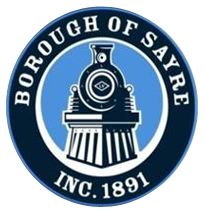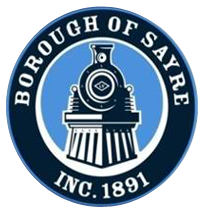A little bit of Our History
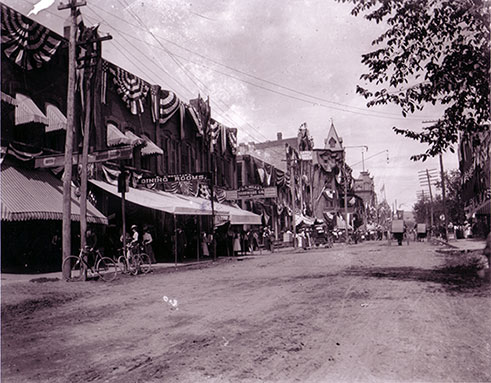
Sayre was born in the mind of Howard Elmer, a 36-year old Waverly, NY bank president, who was born in Orange County, NY and died in South Bethlehem, PA and never lived a day in Sayre in his life.
In 1869 Howard Elmer, the founder and president of the Waverly First National Bank, saw the possibilities in the plains between Athens and his home community for the establishment of a town.
He persuaded his brother Richard Elmer, a New York City capitalist, Charles Anthony; and a Waverly man by the name of James Fritcher in 1870 to join him in purchasing 321 acres of what farmers had referred to as pretty poor farmland: the Morley, Hopkins and William Thomas farms in an area south of Waverly called Pine Plains.
Without letting grass grow underneath his feet, he started construction of an 80-foot wide thoroughfare from Bradford Street to what is now W. Lockhart Street, which he called Keystone Avenue. The street ran through the above mentioned farms and cost $3,000.
During the winter of 1870-71, Elmer was forced to quickly revise the original location of his community when he saw that the proposed town should be located near the terminus of two railroads: the Southern Central and the Geneva, Ithaca and Athens Railroads.
Elmer accomplished this through the purchase of 417 more acres of plains, through the Leggett, Harris and Hayden properties and more of Thomas’ land. With $140,000 they had purchased 738 acres, including the area surrounding the two railroads—about halfway between Athens and Waverly.
LVRR Boosted Sayre’s growth. Historians tell us that Elmer was assured when he sank $140,000 into poor farm land, "dense growths of pitch pine and scrub oak timber," that the railroad would move its repair work from modest Waverly to the new location.
What Elmer was "banking" on was the successful merger and hook-up of the smaller New York based roads with Asa Packer’s Lehigh Valley Railroad (originally the Pennsylvania and New York Canal and Railroad Company).
That section of the Lehigh Valley had already linked up with the Erie Railroad at Waverly (in 1869) and talks were underway to bring the Geneva, Ithaca and Athens (soon to be Sayre) and Southern Central railroads into Packer’s Lehigh "family."
Pennsylvania’s anthracite coal was the real impetus for the expansion, as Asa Packer constantly sought to stretch the tracks farther and farther away from his home base in Mauch Chunk, PA.
When he was ready to use land to build shops and a round house, he naturally turned to Howard Elmer, who had been a part of the merger talks for the past two years.
In 1871, Packer purchased 69 of the 738 acres owned by Elmer and his partners—and the boom was on!
Street grading began in 1872, with the clearing of land, and the planting of trees near the sides of the streets-to-be. Lehigh Avenue was located and graded in 1873. In that same year, the first depot—dubbed the "Cow pasture Station"—was built.
John Sheehan bought the first lot on North Lehigh Avenue and built a house there. Others were soon to follow.
Packer and Thomas Avenues and Desmond, Hayden and Sayre Streets were laid out. The later was changed to Lockhart after the town was named.
The Waverly newspaper in 1873,"The Advocate," published a statement concerning the infant community:
"Southern Central Junction is a station halfway between Waverly and Athens, Pennsylvania, at the junction of Ithaca and Athens and the Southern Central railroads with the Lehigh Valley. Previous to last Monday it had not been used as a passenger station. Owing to the enterprise of Howard Elmer, a passenger station has been erected at this point and the Ithaca and Athens trains will terminate here instead of Athens. A restaurant will soon be opened." Robert Sayre’s namesake.
According to local "legend," recorded by Mrs. J. W. Bishop in 1912:
"Mr. Elmer took a party of railroad men to the hillside about where the reservoir now is to give them a view of the situation. All were greatly impressed by the beauty and extent of the plain and Robert H. Sayre, president of the Pennsylvania and New York Railroad Company and superintendent of the Lehigh Valley, exclaimed:
"What a magnificent location for a great city!"
"Mr. Sayre’s judgment was considered valuable and Mr. Elmer said:"
"If that is your opinion, Mr. Sayre, we will build a town and call it by your name, which was done at that time."
Asa Packer had appointed Sayre as engineer in charge of location and construction of the original line in 1852. Until his retirement in 1898 he remained in charge of the various extensions of the system.
Sayre receives charter according to records, 278 "freeholders" residing in an area between South Waverly and Athens Pennsylvania, signed a petition asking that Sayre be recognized as a borough.
That petition was presented to and heard by a grand jury September 3, 1890. Pine Plains, the area we now call Sayre, was officially described as that land bound by a line beginning on "the boundary line between the States of New York and Pennsylvania, on the East bank of said Cayuta Creek and following, on down the East bank of said creek the several courses and distances thereof to the Susquehanna River…" on its east side.
The Town of Sayre was decreed to be "The Borough of Sayre," in "corporate style and title thereof." And, with signature of Judge Sittser affixed, as of January 27, 1891, Sayre was officially official.
(This was originally written by Clara Costen for the Evening Times Centennial addition in 1991 it was copied and corrected by Henry G. Farley in 2010.)
In 1869 Howard Elmer, the founder and president of the Waverly First National Bank, saw the possibilities in the plains between Athens and his home community for the establishment of a town.
He persuaded his brother Richard Elmer, a New York City capitalist, Charles Anthony; and a Waverly man by the name of James Fritcher in 1870 to join him in purchasing 321 acres of what farmers had referred to as pretty poor farmland: the Morley, Hopkins and William Thomas farms in an area south of Waverly called Pine Plains.
Without letting grass grow underneath his feet, he started construction of an 80-foot wide thoroughfare from Bradford Street to what is now W. Lockhart Street, which he called Keystone Avenue. The street ran through the above mentioned farms and cost $3,000.
During the winter of 1870-71, Elmer was forced to quickly revise the original location of his community when he saw that the proposed town should be located near the terminus of two railroads: the Southern Central and the Geneva, Ithaca and Athens Railroads.
Elmer accomplished this through the purchase of 417 more acres of plains, through the Leggett, Harris and Hayden properties and more of Thomas’ land. With $140,000 they had purchased 738 acres, including the area surrounding the two railroads—about halfway between Athens and Waverly.
LVRR Boosted Sayre’s growth. Historians tell us that Elmer was assured when he sank $140,000 into poor farm land, "dense growths of pitch pine and scrub oak timber," that the railroad would move its repair work from modest Waverly to the new location.
What Elmer was "banking" on was the successful merger and hook-up of the smaller New York based roads with Asa Packer’s Lehigh Valley Railroad (originally the Pennsylvania and New York Canal and Railroad Company).
That section of the Lehigh Valley had already linked up with the Erie Railroad at Waverly (in 1869) and talks were underway to bring the Geneva, Ithaca and Athens (soon to be Sayre) and Southern Central railroads into Packer’s Lehigh "family."
Pennsylvania’s anthracite coal was the real impetus for the expansion, as Asa Packer constantly sought to stretch the tracks farther and farther away from his home base in Mauch Chunk, PA.
When he was ready to use land to build shops and a round house, he naturally turned to Howard Elmer, who had been a part of the merger talks for the past two years.
In 1871, Packer purchased 69 of the 738 acres owned by Elmer and his partners—and the boom was on!
Street grading began in 1872, with the clearing of land, and the planting of trees near the sides of the streets-to-be. Lehigh Avenue was located and graded in 1873. In that same year, the first depot—dubbed the "Cow pasture Station"—was built.
John Sheehan bought the first lot on North Lehigh Avenue and built a house there. Others were soon to follow.
Packer and Thomas Avenues and Desmond, Hayden and Sayre Streets were laid out. The later was changed to Lockhart after the town was named.
The Waverly newspaper in 1873,"The Advocate," published a statement concerning the infant community:
"Southern Central Junction is a station halfway between Waverly and Athens, Pennsylvania, at the junction of Ithaca and Athens and the Southern Central railroads with the Lehigh Valley. Previous to last Monday it had not been used as a passenger station. Owing to the enterprise of Howard Elmer, a passenger station has been erected at this point and the Ithaca and Athens trains will terminate here instead of Athens. A restaurant will soon be opened." Robert Sayre’s namesake.
According to local "legend," recorded by Mrs. J. W. Bishop in 1912:
"Mr. Elmer took a party of railroad men to the hillside about where the reservoir now is to give them a view of the situation. All were greatly impressed by the beauty and extent of the plain and Robert H. Sayre, president of the Pennsylvania and New York Railroad Company and superintendent of the Lehigh Valley, exclaimed:
"What a magnificent location for a great city!"
"Mr. Sayre’s judgment was considered valuable and Mr. Elmer said:"
"If that is your opinion, Mr. Sayre, we will build a town and call it by your name, which was done at that time."
Asa Packer had appointed Sayre as engineer in charge of location and construction of the original line in 1852. Until his retirement in 1898 he remained in charge of the various extensions of the system.
Sayre receives charter according to records, 278 "freeholders" residing in an area between South Waverly and Athens Pennsylvania, signed a petition asking that Sayre be recognized as a borough.
That petition was presented to and heard by a grand jury September 3, 1890. Pine Plains, the area we now call Sayre, was officially described as that land bound by a line beginning on "the boundary line between the States of New York and Pennsylvania, on the East bank of said Cayuta Creek and following, on down the East bank of said creek the several courses and distances thereof to the Susquehanna River…" on its east side.
The Town of Sayre was decreed to be "The Borough of Sayre," in "corporate style and title thereof." And, with signature of Judge Sittser affixed, as of January 27, 1891, Sayre was officially official.
(This was originally written by Clara Costen for the Evening Times Centennial addition in 1991 it was copied and corrected by Henry G. Farley in 2010.)
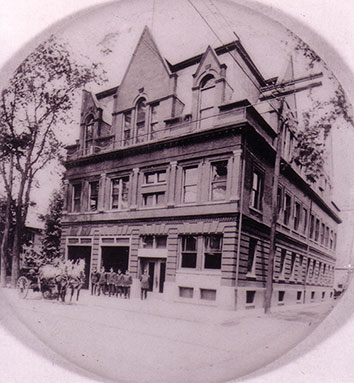
Sayre Borough Hall is One Hundred Years Old by Henry G. Farley
Planning for a new building to house the Sayre Borough offices and Fire Company began in 1906 but the building was not completed until 1908. Originally called "City Hall" the building is currently known as Sayre Borough Hall. Except for a disruption from an arson fire in 1987 and an oil spill and furnace explosion in 2002 the building has been the center of municipal services for 100 years.
On October 17, 1907 Ordinance 103 was passed by the Sayre Borough Council. This ordinance read "Authorizing the erection and construction of a town hall for the Borough of Sayre on the lot now owned by the said Borough on the North side of Packer Avenue, Sayre, Pennsylvania. According to the plans made by Pierce and Bickford Architects of Elmira, New York, the cost shall not exceed $25,000."
According to a local news article that followed the October 17, Council meeting, several years of deliberation and talk had preceded the decision to build a new town hall in Sayre, plans to be followed for construction had been procured a year or more before so there may be some alterations in them before the building is completed.
Planning for a new building to house the Sayre Borough offices and Fire Company began in 1906 but the building was not completed until 1908. Originally called "City Hall" the building is currently known as Sayre Borough Hall. Except for a disruption from an arson fire in 1987 and an oil spill and furnace explosion in 2002 the building has been the center of municipal services for 100 years.
On October 17, 1907 Ordinance 103 was passed by the Sayre Borough Council. This ordinance read "Authorizing the erection and construction of a town hall for the Borough of Sayre on the lot now owned by the said Borough on the North side of Packer Avenue, Sayre, Pennsylvania. According to the plans made by Pierce and Bickford Architects of Elmira, New York, the cost shall not exceed $25,000."
According to a local news article that followed the October 17, Council meeting, several years of deliberation and talk had preceded the decision to build a new town hall in Sayre, plans to be followed for construction had been procured a year or more before so there may be some alterations in them before the building is completed.
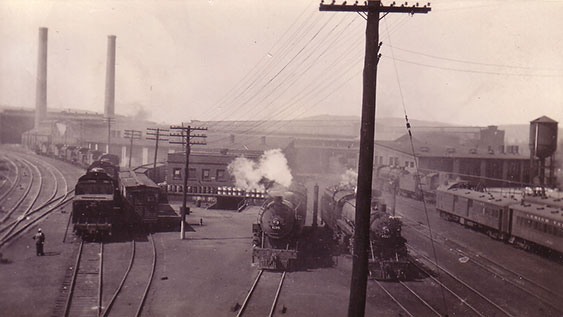
A special meeting of the Sayre Borough Council was held in the R. A. Packer Hose Company rooms on January 21, 1908 for the purpose of transacting business related to the erection and construction of a Town Hall for the Borough of Sayre. It was decided at this meeting to put the project out for bid.
On February 25, 1908 13 Bids were opened for the Town Hall and Fire Department Building project. The bid was awarded to John Beuger of Corning, New York his bid being $19,990 and a completion date of six months from the start of construction. In April of 1908, 30 coupon bonds for $500 each bearing an interest of 4 1/2% each were sold to finance the project.
I have not uncovered a construction start date but by June 25, 1908 Mr. Beuger is offering the Borough two complete fire places for $170 each and windows on the West side of the building for $10 each. On August 3 a figure is presented to council for finishing the hayloft and changing the front doors of the fire apparatus room.
On November 11, 1908 the Athens Gazette reported "The new town hall is nearly completed, the finishing coat of varnish being on the lower floor, and the last of the plumbing fixtures installed. Some of the Council have advanced the idea of holding a formal dedication on New Year’s Day. It will in all probability be used before that time, but the dedication can be done then, and every citizen can have the opportunity of inspecting the building, which is a credit to the borough." The paper further reported on November 25, "The borough council at an adjourned meeting Thursday evening on recommendation of the building committee, accepted the new town hall; and hereafter the meetings of that body will be held in its council chamber. A committee, consisting of the president of the council, burgess and three councilmen, was appointed to arrange for a formal dedication of the building and the date for it has been set on New Year’s eve. An appropriation of $50 was made for this purpose. The new building is the finest in the section and the council and fire department will arrange to have a very large gathering at the dedication." On December 30 the Sayre news included "The dedication committee of the borough council held a meeting Monday evening and completed plans for the formal opening and dedication of the new town hall on Thursday evening. Invitations have been extended to the councils of Waverly, South Waverly and Athens and the executive officers of the same places and a general invitation extended to all the townspeople to be present and to inspect the new building. The firemen who also have quarters in the building will also entertain their friends, and two orchestras have been engaged to furnish music, one on the third floor in the hall for those who wish to dance and the other on the first floor in the council rooms. Refreshments will be served."
On December 31, 1908 the Waverly Press reported "Opening of the New Town Hall, Great Preparations were made for the dedication of the new building."
This evening New Year’s Eve, marks the formal opening of the new town hall at Sayre, and from present indications it will be an affair long to be remembered and the ceremonies will be carried out in a manner that has seldom been equaled on occasions of this nature.
The borough council has had some trouble getting around to this opening. They have had their difficulties with the contractor and other less important matters have turned up to delay the work but at last all these are overcome and although they say the building leaks in places, the borough council need have no fear with the amount of rain that is falling in this section at the present time. Anyway a better time could not have been selected for this grand opening than New Year’s Eve. The building with all of its rumored faults will start the New Year off right and who knows but that it will improve with age. The entire building from basement to the roof will be thrown open to the public and amid strains of music, addresses by officials from neighboring towns and villages, everyone will be expected to have a good time. Dancing will be indulged and lemonade will be served."
The Athens Gazette reported the following on January 6, 1909
"From early evening until midnight the new town hall in Sayre was crowded with people New Years Eve at the formal opening. The handsome new municipal building was ablaze with light from the basement to tower and the throngs of sightseers explored every nook and corner with the satisfaction that it belonged to them as citizens of Sayre. A platform had been erected in the large public hall which occupies the entire third floor and the "doings" started with speeches in which Waverly, Sayre and Athens citizens took part. Following the addressees the young people were given the opportunity to dance."
On February 25, 1908 13 Bids were opened for the Town Hall and Fire Department Building project. The bid was awarded to John Beuger of Corning, New York his bid being $19,990 and a completion date of six months from the start of construction. In April of 1908, 30 coupon bonds for $500 each bearing an interest of 4 1/2% each were sold to finance the project.
I have not uncovered a construction start date but by June 25, 1908 Mr. Beuger is offering the Borough two complete fire places for $170 each and windows on the West side of the building for $10 each. On August 3 a figure is presented to council for finishing the hayloft and changing the front doors of the fire apparatus room.
On November 11, 1908 the Athens Gazette reported "The new town hall is nearly completed, the finishing coat of varnish being on the lower floor, and the last of the plumbing fixtures installed. Some of the Council have advanced the idea of holding a formal dedication on New Year’s Day. It will in all probability be used before that time, but the dedication can be done then, and every citizen can have the opportunity of inspecting the building, which is a credit to the borough." The paper further reported on November 25, "The borough council at an adjourned meeting Thursday evening on recommendation of the building committee, accepted the new town hall; and hereafter the meetings of that body will be held in its council chamber. A committee, consisting of the president of the council, burgess and three councilmen, was appointed to arrange for a formal dedication of the building and the date for it has been set on New Year’s eve. An appropriation of $50 was made for this purpose. The new building is the finest in the section and the council and fire department will arrange to have a very large gathering at the dedication." On December 30 the Sayre news included "The dedication committee of the borough council held a meeting Monday evening and completed plans for the formal opening and dedication of the new town hall on Thursday evening. Invitations have been extended to the councils of Waverly, South Waverly and Athens and the executive officers of the same places and a general invitation extended to all the townspeople to be present and to inspect the new building. The firemen who also have quarters in the building will also entertain their friends, and two orchestras have been engaged to furnish music, one on the third floor in the hall for those who wish to dance and the other on the first floor in the council rooms. Refreshments will be served."
On December 31, 1908 the Waverly Press reported "Opening of the New Town Hall, Great Preparations were made for the dedication of the new building."
This evening New Year’s Eve, marks the formal opening of the new town hall at Sayre, and from present indications it will be an affair long to be remembered and the ceremonies will be carried out in a manner that has seldom been equaled on occasions of this nature.
The borough council has had some trouble getting around to this opening. They have had their difficulties with the contractor and other less important matters have turned up to delay the work but at last all these are overcome and although they say the building leaks in places, the borough council need have no fear with the amount of rain that is falling in this section at the present time. Anyway a better time could not have been selected for this grand opening than New Year’s Eve. The building with all of its rumored faults will start the New Year off right and who knows but that it will improve with age. The entire building from basement to the roof will be thrown open to the public and amid strains of music, addresses by officials from neighboring towns and villages, everyone will be expected to have a good time. Dancing will be indulged and lemonade will be served."
The Athens Gazette reported the following on January 6, 1909
"From early evening until midnight the new town hall in Sayre was crowded with people New Years Eve at the formal opening. The handsome new municipal building was ablaze with light from the basement to tower and the throngs of sightseers explored every nook and corner with the satisfaction that it belonged to them as citizens of Sayre. A platform had been erected in the large public hall which occupies the entire third floor and the "doings" started with speeches in which Waverly, Sayre and Athens citizens took part. Following the addressees the young people were given the opportunity to dance."
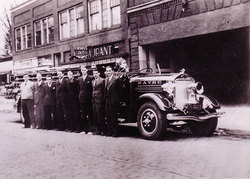
The Sayre Borough Hall was in use continuously until Labor Day September 7, 1987 when a four alarm fire destroyed the offices in the building. Investigators at the time termed the fire as arson and felt that the fire was started by a fire bomb thrown through the front window of the police station.
The fire was reported at approximately 5:28 a.m. by John Nobles who lived in the building. Nobles, his wife and two children escaped injury in the blaze, which sent four firefighters to the hospital for treatment of smoke inhalation and exhaustion. The office portion of the building, the council chambers and the police department were heavily damaged in the fire and had to be relocated until a structural study could be done on the building to determine if it could be saved. The Borough offices were moved to the Penelec Building on Rt. 199 near the town border. The Nobels family was also displaced and had to live outside the building for a time. The National Fire Judgment Corporation was able to secure $143,049.08 insurance money for the borough and after having a structural study done on the building it was decided to move forward with renovations. In February of 1988 the borough council voted to advertise the first floor renovations the bid was awarded to Homer Gow and Son of Vestal, NY for $35,567. The Nobles apartment was approved for renovation in March not to exceed $2,500. In May the second floor renovations were bid and again Homer Gow was awarded the contract for $15,145. The Borough offices moved back into the Borough Hall in May of 1988 and the final phase of the fire renovation the exterior of the building was bid in June. Homer Gow won this bid as well for a sum of $20,184. By August of 1988 almost a year after the fire the renovations were winding down.
The fire was reported at approximately 5:28 a.m. by John Nobles who lived in the building. Nobles, his wife and two children escaped injury in the blaze, which sent four firefighters to the hospital for treatment of smoke inhalation and exhaustion. The office portion of the building, the council chambers and the police department were heavily damaged in the fire and had to be relocated until a structural study could be done on the building to determine if it could be saved. The Borough offices were moved to the Penelec Building on Rt. 199 near the town border. The Nobels family was also displaced and had to live outside the building for a time. The National Fire Judgment Corporation was able to secure $143,049.08 insurance money for the borough and after having a structural study done on the building it was decided to move forward with renovations. In February of 1988 the borough council voted to advertise the first floor renovations the bid was awarded to Homer Gow and Son of Vestal, NY for $35,567. The Nobles apartment was approved for renovation in March not to exceed $2,500. In May the second floor renovations were bid and again Homer Gow was awarded the contract for $15,145. The Borough offices moved back into the Borough Hall in May of 1988 and the final phase of the fire renovation the exterior of the building was bid in June. Homer Gow won this bid as well for a sum of $20,184. By August of 1988 almost a year after the fire the renovations were winding down.
The re-organization of the Sayre Borough Council in 2002 was moved to the Old Lehigh Valley Passenger Station in Sayre due to the fact that there had been remediation going on in the building since a strong petroleum odor permeated the building in October 2001. In March of 2002 just as the remediation of the building was complete and the council and offices ready to move back in an explosion occurred in the basement of the building that was caused by a leaking propane gas tank on a delivery truck in the alley beside the borough hall. This explosion did some cosmetic damage to the inside of the building and kept the borough office employees from returning to the building until much later in the year. During this displacement the Borough offices were re-located to the Blue Swan Mill building in Sayre and the council continued to meet in the Lehigh Passenger station. A new ventilation system was installed in the building and several areas painted and carpeted thus making the building available for use by the Borough.
Still in use today by the Fire Company and Borough offices, the stately building is one of the nicest in town.
Still in use today by the Fire Company and Borough offices, the stately building is one of the nicest in town.
